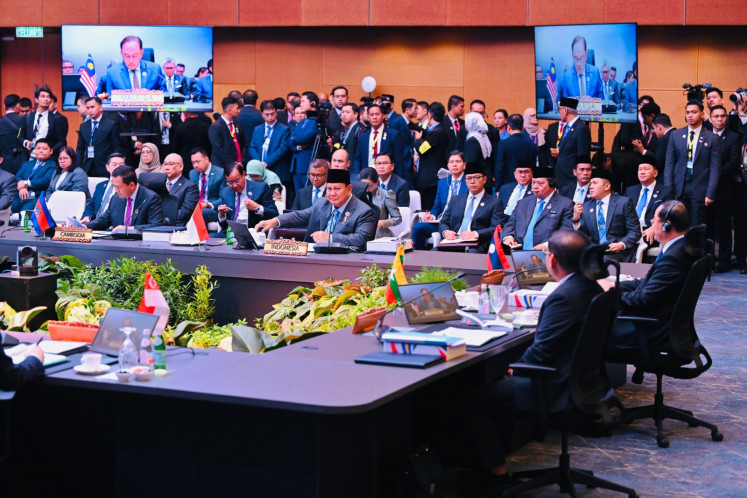Popular Reads
Top Results
Can't find what you're looking for?
View all search resultsPopular Reads
Top Results
Can't find what you're looking for?
View all search resultsANALYSIS: Banking industry remains challenging in 2017
The banking industry in Indonesia is still in a very tough condition
Change text size
Gift Premium Articles
to Anyone
The banking industry in Indonesia is still in a very tough condition. Latest data showed that loan growth is still slowing to 6.5 percent year-on-year (yoy) in September 2016, the slowest pace since 2009, while deposit growth slowed sharply to only 3.2 percent, the lowest growth ever.
The banks that suffered the most were small ones. Loans and deposits of banks in the BUKU I category, those which have core capital less than Rp 1 trillion (US$75 million), plunged by 45.1 percent and 48.4 percent, respectively. Meanwhile, loans and deposits of BUKU IV banks, those which have a core capital of more than Rp 30 trillion, are still growing by 13.5 percent and 8 percent year-on-year (yoy).
Bank Indonesia’s (BI) banking survey in the third quarter suggested that demand for new loans remains weak because lending rates are relatively high and the financing risks are increasing. Banks are also still reluctant to boost loans as asset quality has not been improving significantly. The non-performing loan (NPL) ratio of commercial banks remained relatively high at 3.1 percent in September.
Deteriorating asset quality has had an impact on banks’ profitability. The provisioning of some banks has increased significantly. Based on Mandiri Sekuritas’ data, the provisioning of 12 banks jumped 44 percent yoy in October 2016. Among the big banks, Bank Mandiri and Bank Central Asia (BCA) posted the highest provisioning growth of 90 percent and 87 percent, respectively, stemming from rising NPL.
Luckily, BCA still managed to have positive earnings growth of 13 percent, while earnings of Bank Mandiri contracted quite significantly, by 20 percent yoy. Liquidity is also getting worse as deposit growth plunged. Loan to deposit ratio (LDR) of nationwide commercial banks jumped to 91.7 percent, the highest level this year.
Domestic economic conditions remain weak. Gross domestic product (GDP) growth in the third quarter slowed to 5.02 percent yoy, from 5.28 percent in the previous quarter, and there is a possibility that the economy will slow further in the last quarter of this year.
Macroeconomic indicators are still showing mixed performances. Cement sales contracted by 6.6 percent yoy, worse than September’s figure of minus 2.7 percent, and the fiscal condition are still getting tighter, with a deficit of 2.1 percent in the same month. The industrial production index fell from 134.8 in August to 131 in September, and industrial capacity utilization fell from 77 percent in the second quarter to 76.2 percent in the third quarter this year.
There are still uncertainties in the global economy as well, especially from the prospects of the US economy under the new president-elect, the impact of “Brexit” — Britain’s decision to leave the European Union — on the UK and European economies, as well as the Chinese economy and other emerging economies that keep getting worse.
The volatility of the financial markets since the US election makes things even worse. The rupiah last month depreciated sharply from 13,050 to 13,500, the yield of the 10-year Indonesian government bond jumped from 7 percent to 8.3 percent while the benchmark stock index, Jakarta Composite Index (JCI), fell from 5,450.3 to 5,136.7. The good news is that the consumer confidence and consumer expectation index sharply increased in October to 116.8 and 130.4, respectively, the highest levels since January 2015.
The volatility of financial markets limits room for BI to loosen further, and now the central bank is even considering changing course to tightening as the rupiah keeps on weakening, together with other emerging currencies.
BI began its looser monetary cycle early last year. Since January 2015, BI has cut policy rates by as much as 175 basis points (bps). Implicitly, with the change of policy rate from the BI rate to the BI seven-day reverse repo rate, BI has cut the policy rate by 300 bps. BI has also loosened its macro prudential policy by relaxing the loan to value ratio (LTV), financing to value ratio (FTV) of loans/financing for housing ownership and cutting the reserve requirement ratio quite aggressively from 7.5 percent to 6.5 percent in March 2016.
We hope that this series of monetary and macro prudential loosening will have a more positive impact in the next couple of months. Meanwhile on the fiscal side, the conditions have gotten tighter as the realization of government spending is significantly higher than the tax revenue growth.
The latest data showed the total fiscal deficit reached Rp 268.4 trillion, or 2.14 percent of total GDP. Finance Minister Sri Mulyani Indrawati expects that there will be a shortfall in tax revenue this year of Rp 219 trillion and the public spending had been cut by Rp 137.5 trillion for the rest of 2016. Hence, it is quite difficult for government spending to make a significant contribution to economic growth for the rest of this year, and probably, next year as well.
The risks and challenges are still high for the banking industry and for the whole macroeconomic conditions next year. With all of the uncertainties in the global economy, fluctuation in the financial market and weak domestic economic conditions, banks will still have to undertake cautious steps.
The most important thing for banks is to prioritize the stability of banking indicators, including asset quality, liquidity and capital adequacy, over profitability and credit growth.
Loan growth will probably not grow by more than 20 percent as in 2013, but it will likely grow at the new equilibrium of around 10 to 15 percent in the next couple of years. We forecast total banking industry loan growth of 13.5 percent next year as economic growth will only slightly improve to 5.1 percent after growing 5 percent this year.
Loan growth of more than 20 percent has proven to be unsustainable and has caused the deterioration of asset quality. Banks will have to be less dependent on income from loans. Banks will have to operate more efficiently, by optimizing the operation of branches and also optimizing the utilization of information technology without lessening service quality to the customers.
_______________
The writer is senior financial market analyst at Bank Mandiri.
------------------
To receive comprehensive and earlier access to The Jakarta Post print edition, please subscribe to our epaper through iOS' iTunes, Android's Google Play, Blackberry World or Microsoft's Windows Store. Subscription includes free daily editions of The Nation, The Star Malaysia, the Philippine Daily Inquirer and Asia News.
For print subscription, please contact our call center at (+6221) 5360014 or subscription@thejakartapost.com










